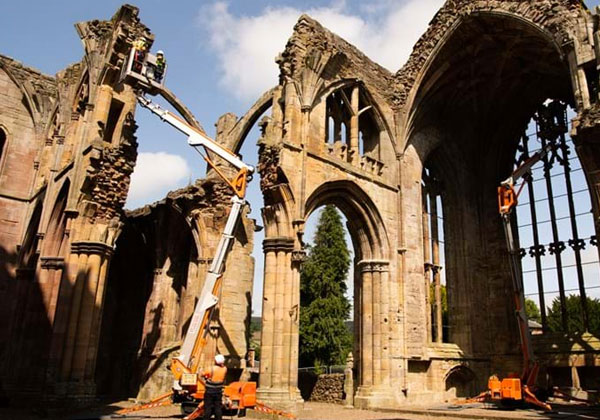Historic Environment Scotland (HES) has announced the introduction of new measures to manage the impact of climate change on Scotland's national heritage sites.
HES are implementing a new approach to the inspection of historic properties in response to the effects of climate change. A programme of tactile condition surveys on over 200 properties will assess the extent of deterioration of high-level masonry and ensure public safety against the risk of potentially unstable building fabric. It will mean that access to some properties will be restricted to enable surveys to be conducted.
Scotland's public heritage body, which cares for 336 historic buildings and sites across Scotland, believes the programme is a proactive step towards transforming the way the nation's most precious places are protected, repaired and experienced in the face of accelerating decay from climate change.
The tactile survey programme, which is the result of ongoing risk assessment and sample surveys, will assess the impact of climate change, as well as the scale of deterioration caused by a number of other factors, including the materials used in the building's construction, its age and physical location. It is anticipated remedial works could require significant investment over multiple years and, in some instances, require a different management approach to be taken than before.
To ensure public safety, and in response to concerns relating to the risk of failing historic building fabric, HES had embarked on a national project to assess risks to visitors and staff across the properties in care in 2019. Post-lockdown, work was restarted and surveys conducted in spring 2021 identified potentially dangerous fabric at high level, leading to immediate access restrictions at 20 properties for inspection to ensure visitors and staff were not exposed to any possible risks.
The sample surveys conducted on these properties confirmed to conservation specialists at HES that the type of deterioration being seen could only be assessed properly by hands-on, tactile surveys and that the traditional ways of inspecting at high level, such as visual inspection from the ground or by drone, while useful, are not as accurate as a hands-on inspection.
These surveys will inform a programme of repairs, conservation work, adaptation measures, interventions and new ways of caring for these historic assets. Access restrictions were put in place at a further 11 sites in November 2021, with an additional 39 sites following in January 2022 as a precautionary measure because HES assessments showed that the issues found at the initial sites could potentially pose a risk to properties with shared characteristics.
Dr David Mitchell, director of conservation at HES, said: "The safety of staff, visitors and contractors is our priority and access restrictions at some sites will unfortunately be necessary.
"Our routine inspections are increasingly revealing the deterioration of building fabric at high level. While our changing climate is not the sole reason for deterioration, it has certainly accelerated it and brought the issue to a head. Historic properties are inherently fragile by their nature, often ruinous and standing at exposed locations. We face a constant battle against time and the elements.
"Across the world, cultural heritage assets are seen as barometers of change and they demonstrate the challenges for the historic environment and traditionally constructed buildings in the face of a changing climate.
"We are taking proactive action now to assess the nature and scale of the immediate challenge, and to explore a range of solutions and options. It is inevitable our approach to protecting historic buildings will have to change - we need to reimagine how we manage these historic and much-loved places. A range of solutions is needed, including repairs, investment and new and innovative interventions. In some cases reduced physical access and accepting the natural process of decay will need to be considered."
While the work is taking place, HES is looking at alternative ways to share Scotland's story with the many visitors, members and people across Scotland who engage with the sites which it manages. This includes looking at opportunities to provide partial access at some of the sites where it is safe to do so, while more interpretative performances, the use of innovative technology and new audio tours, videos and trails are also being considered to augment the visitor experience for 2022. HES is committed to opening up as much access as possible as the work progresses.
While the inspection programme is taking place, many of Scotland's most loved historic visitor attractions remain open to the public, including Edinburgh Castle, Skara Brae, Stirling Castle, Fort George, Arnol Blackhouse, Urquhart Castle and many more across the length and breadth of Scotland.
Time and date
CONSTRUCTION DIRECTORY
Construction News
21/01/2022
Historic Environment Scotland Announce New Environmental Measures

Latest Construction News
26/11/2024
Scottish Water has unveiled its largest-ever procurement initiative, aiming to modernise the nation's water and wastewater infrastructure while safeguarding the environment. The program, named Delivery Vehicle 4, is valued between £5 billion and £9 billion and is set to run from 2027 to 2033, with ...
26/11/2024
The City of Edinburgh Council has granted planning permission, subject to conditions, for the refurbishment of Calton Square, an office building currently occupied by Baillie Gifford until the end of December 2025. Promoted by Ardstone Capital on behalf of Manova Partners, the project aims to ...
26/11/2024
First Minister John Swinney, MSP for Perthshire North, praised the progress being made on the construction of the new Perth High School during a visit on Friday, 22 November. He was joined by Jim Fairlie, MSP for Perthshire South and Kinross-shire, alongside senior Perth and Kinross Councillors, ...
26/11/2024
A state-of-the-art playpark has officially opened at King George V Park in Bearsden, following the completion of a £100,000 refurbishment. Funded by a combination of East Dunbartonshire Council (EDC) Capital Funding and the Scottish Government’s Renewing Scotland’s Play Parks initiative, the ...
26/11/2024
Fife Council has launched a public consultation, inviting residents, businesses, and organizations to contribute ideas and propose sites for inclusion in the next Local Development Plan, known as Fife's Place Plan. The council is calling on community councils, landowners, and developers to share ...
26/11/2024
The Chief Executive of East Lothian Council has announced she is to retire in February 2025. Monica Patterson who has been Chief Executive for almost five years, has spent most of her professional career working in local government. Prior to joining East Lothian Council in 2010, she was Head of ...
25/11/2024
West of Scotland Housing Association (WSHA) and Connect Modular have jointly submitted a planning application to Glasgow City Council for the development of 33 affordable homes in Cowlairs. This project aligns with the wider Cowlairs Park regeneration scheme and the city's ambitious housing ...
25/11/2024
Arc-Tech (Scotland) has successfully completed a £6m Mechanical and Electrical (M&E) services package for the Lost Shore Surf Resort in Edinburgh. The state-of-the-art resort, which opened its doors earlier this month, features a range of amenities, including a wave pool, luxury lodges, and ...
25/11/2024
Scottish Water has successfully completed the construction of a groundbreaking hydro energy generation scheme at Whiteadder Reservoir in East Lothian. This innovative project, believed to be the first of its kind in Europe, will harness the power of water to offset a significant portion of the ...
25/11/2024
Work is set to commence on a £6.5 million project to upgrade the Double Dykes Gypsy/Traveller site near Perth. The initiative aims to replace outdated chalets with modern, energy-efficient accommodation and implement significant site improvements. Perth & Kinross Council secured £3.9 million from ...

















